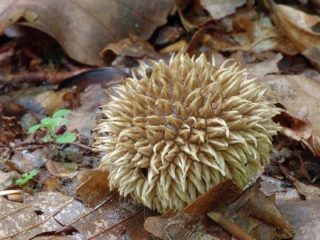Content
Semi-bronze boletus is a rare mushroom with autumn fruiting. To find it in the forest, you should familiarize yourself with false doubles and study the features of its appearance.
What do semi-bronze boletes look like?
A mushroom with a large cap, reaching up to 17-20 cm in diameter and up to 4 cm in thickness. In young boletes it is convex, closer in shape to a ball, but as the fruiting body grows, it straightens out.
The color of the cap is gray-brown; in adult representatives, yellowish spots appear on it. In dry, hot weather it becomes covered with cracks.
On the underside of the cap, the tubular layer is white with a grayish tint. In adult representatives, it changes shade to olive green. The tubes are easily separated from the hat pulp. Their length varies between 20-40 mm.
The mushroom rises 12 cm above the ground, the thickness of the stem reaches 40 mm. It is dense, thick, similar in appearance to a mace or tuber, and has a mesh pattern. As it grows, the leg becomes more cylindrical, with a wrinkled surface, pinkish-beige, and then olive-white in color.
Where do semi-bronze boletes grow?
On the territory of the Russian Federation, bolete is rare. The main place of its growth is the southern regions, where the climate is predominantly hot with high rainfall. Semi-bronze boletus is more common in moist soils rich in humus.
Fruiting bodies are collected in mixed forests, where oak, beech, and pine trees grow. You can find both single semi-bronze boletes and small groups of 2-3 representatives.
Is it possible to eat semi-bronze boletes?
The mushroom is considered edible. It is actively collected and eaten in the Mediterranean.
Taste qualities of semi-bronze bolet
The mushroom is a delicacy. Gourmets appreciate it for its mild, pleasant taste. In terms of comparative characteristics, the semi-bronze bolet is superior to the porcini mushroom in terms of richness of taste and brightness. The smell of the delicacy is weak and appears after cooking. The aroma is good if the fruit body is dried.
False doubles
The semi-bronze bolet has no exact counterparts. It can be confused with other fruiting bodies due to its appearance.
Looks like a semi-bronze bolet Polish mushroom: Adult representatives of the species have the same cylindrical leg and cushion-shaped cap in chocolate or chestnut shades.
To distinguish them, it is necessary to examine the fruiting body: the Polish species has white flesh that quickly turns blue when exposed to oxygen.
One can confuse semi-bronze bolet with bronze boletus. This one is distinguished by a darker colored cap and the absence of a mesh pattern on the stem.
It is necessary to distinguish pain from gall fungus. Gorchak has a similar structure, so to recognize it, you need to study the leg. In the gall fungus it has vascular veins.
Collection rules
When choosing a location, you should study mixed forests by visiting them in August-September. The collection site should be located away from highways and industrial facilities.
Collection should be done using a sharp knife: carefully cut at the root. It is not recommended to pull out or break off fruiting bodies; there is a high risk of damage to the mycelium.
Use
Semi-bronze bolet can be eaten in any form, except raw. When cooking, after washing, housewives boil the pulp and then fry or marinate.
You can dry the fruiting bodies to use them in future recipes.
Principles of mushroom processing:
- remove all foliage and small debris from the pulp, cut off the lower part of the fruit body, rinse under running water;
- Place the mushrooms in a bowl of cold water for 15 minutes, then boil with salt for 20 minutes if you plan to fry the product, and 40 minutes if the semi-bronze bolet needs to be marinated or consumed boiled.
Conclusion
Semi-bronze boletus is usually classified as an edible mushroom. It has a delicate aroma and mild taste, and is universal in use. Its main habitat is mixed forests, where it should be distinguished from false species.













